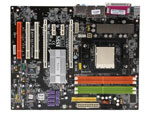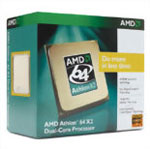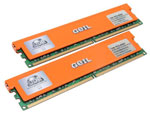Baseline AMD High-End Platform
Starting with the AMD basic high-end offering, it should come as little surprise that you still get a powerhouse of a computer for the cost. A fast processor, dual graphics cards, 2 GB of RAM, and a good amount of hard drive space will keep all but the most demanding users satisfied. We won't be putting together an equivalent Intel system, as we already mentioned, but it could certainly be done. Let's take a closer look at a few of our component choices, and discuss some of the alternatives you might want to consider.
 |
The choice of motherboard determines in a large part what sort of system you are going to build. A high-end gaming system will come with dual X16 PCI-E slots, often with full X16 bandwidth to each slot. The truth of the matter is that PCI Express graphics cards are rarely starved for bandwidth, so dropping down to X8 bandwidth won't have a dramatic impact on performance. We saved about $40 by going with the MSI K9N-SLI Platinum motherboard, which uses the nForce 570 SLI chipset as opposed to the nForce 590 SLI chipset. The motherboard won't overclock quite as far as some other offerings, and during our testing for the review we found that it seemed to hit a brick wall very quickly once you passed a certain point. If you can live with the approximately 315 MHz top bus speed "limitation", however, the board still performs admirably.
 |
Moving on to the processor, we have chosen what is best classified as a moderately fast AMD offering, the Athlon X2 4600+. When the AM2 processors first launched, the 4600+ carried a price tag of nearly $600. We didn't really recommend the processor then, but with the updated price of roughly $250 it becomes a lot more attractive. We considered recommending an upgrade to the 5000+, with a price of roughly $365, but at present many places that stock the CPU at that price are backordered. Besides, as we've already stated, Intel definitely has the performance advantage anyway, so if you're looking at getting a reasonably high-end AMD system you might as well save a bit of money. Overclocking is always an option, and we have found that most dual core AMD AM2 processors top out somewhere between 2.6 and 2.8 GHz without resorting to extreme cooling, in which case you would again be better off saving the money and getting a slightly slower stock clock speed.
 |
The choice of memory sparked some serious debate here at AnandTech, as well as a vigorous search of many vendors along with our own pricing engine in an attempt to find the best performing memory at the lowest cost possible. We mentioned this in our last midrange guide, and we will reiterate the point here:
DDR2 memory prices have skyrocketed over the past couple of months. You could find 2 GB of reasonably performing DDR2 memory for only $150 two months ago, but now the cheapest price you will find for such memory is $200, with the better performing options costing over $250. Given that our baseline AMD configuration is more of a "budget high-end" system, we tried to keep the costs down as much as possible. We still wanted to get some DDR2-800 memory with CL4 timings, however, as memory with those specifications generally marks the beginning of the high-end RAM. Our own memory reviewer relayed the following information, which is worth repeating: "Corsair, Crucial, Kingston, G.Skill, GeIL, Mushkin, OCZ, Patriot, Super Talent, and TEAM (and several others as well) have all been very competitive at the same speed grade in DDR2." Basically, if you buy memory with the same specifications, the difference from one manufacturer to another is not going to be huge. With this in mind, we looked for DDR2-800 memory with good timings and tried to find the lowest current price. As you can see, we ended up with a GeIL Ultra 2x1GB kit. If prices change in the near future and one of the other manufacturers offers DDR2-800 CL4 RAM at a better price, they would get our pick for "budget high-end" memory.
 |
Having selected an SLI motherboard, we of course chose to go with two NVIDIA graphics cards. There are many options currently available, but generally speaking we feel you should get the fastest single card you can purchase up until the GX2 before moving to dual graphics cards. In other words, we would take a single fast 7900 series card over two 7600 GT cards. Once you reach the cost of the GX2 (about $500), many new options open up. Two 7900 GT cards would have been a good choice a month or two back, but these cards have now been displaced with the launch of the 7950 GT and the 7900 GTO. The 7900 GTO is basically a 7900 GTX design, including the large, quiet heatsink/fan, only with lower memory and core clock speeds. Many people have had good results in overclocking the GTO to GTX clock speeds, but even at the stock speeds it will be a very fast card. The only drawback is that the cards are dual slot designs, and the GTO cards don't currently include HDCP support. Relative to the 7900 GT, you will definitely get better performance, as you get twice as much memory with a faster core clock speed.
A near tie in terms of getting our recommendation is the 7950 GT cards. These have a slower clock speed than the GTO but include faster memory, they take up a single slot, and you can get HDCP support. They also cost a bit more than the GTO and they make more noise. We decided to save money and sacrifice expansion slots, and with many games starting to stress GPU core performance rather than memory bandwidth we feel the GTO will be faster. It ends up being a decision between features and price, however, so you should choose whichever appeals to you more.
Rounding out our component selections, we chose to go with a single 320GB hard drive and the obligatory 16X DVD burner. In both cases, we had an eye towards performance as well as price. For 320GB hard drives with 16MB of cache, the Seagate 7200.10 is currently the lowest price and offers compelling performance. You could always go with a smaller or larger hard drive, although the difference in price between 250GB and 320GB isn't very large. With Blu-Ray and HD-DVD on the horizon, DVD burners are all becoming very similar in specifications and performance. Media compatibility will still vary, but if you get the drive manufacturer's recommended brand you shouldn't have any problems, at which point you can simply choose whichever is cheapest. Once again, that honor falls to the NEC ND-3550A, with LG Electronics, BenQ, LiteOn, Pioneer, and others following close behind. The only thing to remember is to get an optical drive with a faceplate that will match your choice of case.
We will wrap up with a brief note on the operating system selection. All of the systems we are putting together today should be fully compatible with Windows Vista once it becomes available, not to mention Windows XP, Linux, and many other operating systems. You should also be able to run either 32-bit or 64-bit versions of any of these operating systems, although the overall performance and compatibility of Windows x64 OSes at present is lower than their 32-bit offerings. You then need to decide which specific package to get within the OS family, and for Windows XP that means choosing between Home, Professional, and Media Center Edition. For anyone that runs more than a single computer on a network, we definitely don't recommend XP Home. Media Center Edition and XP Professional use the same code base, with a few minor differences. We feel MCE is the most versatile choice overall, and the fact that it is $20 cheaper helps to seal the deal. If you plan on running 4GB of memory or more, you will probably want to upgrade to a 64-bit OS, but we will continue to recommend 32-bit Windows and 2GB of RAM for the time being.














45 Comments
View All Comments
limiter - Tuesday, October 10, 2006 - link
I read an article on Toms or HardOCP (that I can't find now) which said they had problems getting one of their DVD drives to work on a P965 ASUS board, but a lot of what I've read comes from Newegg item comments like these for the ASUS P5B Deluxe:For the ASUS P5W DH Deluxe
I've read some other forum comments about DVD problems on ASUS P965 mobos, but I can't find them right now. If I run across them again I will update. I'm not saying this is a bad motherboard or ASUS is a bad company, and any of this could be user error, unrelated bad hardware, or have been corrected by bios updates. I guess I just get the impression there are more people having issues with memory and DVD burners than usual. Nothing I think needs a too much attention. I am happy to see memory was tested for the article, I look forward to the future article mentioned above on this topic!
JarredWalton - Tuesday, October 10, 2006 - link
Of course, all the boards are using 975X in this guide and not P965. The problem likely stems from the fact that none of the P965 boards have an Intel IDE controller, since ICH8 doesn't provide one. (Stupid... but that's a topic for another day.) Most boards use third-party controllers can order to offer IDE support, and some of the initial BIOS revisions were very flaky in memory and IDE support. Beyond that, I can't think of anything specific that would be causing issues for people.JarredWalton - Monday, October 9, 2006 - link
The RAM and motherboard combinations have all been tested (as far as I'm aware) by Gary Key and/or Wesley Fink. Those choices were made with extensive input from Wes and Gary. That's the major sticking point in terms of compatibility - and P965 memory compatibility has improved a lot with the latest BIOS revisions. However, it should be noted that we strongly recommend setting memory timings (and voltages) manually for most high-end enthusiast systems. The SPD settings should work and allow the systems to POST, but they are not optimal by any means. Hope that helps - Gary or Wes might be able to chime in with specific testing results for the RAM+Mobo, although I think there's an article in the works that will cover that aspect regardless.Missing Ghost - Monday, October 9, 2006 - link
Is there really a good reason to choose AM2 over 939? I think the motherboards for 939 are more mature.JarredWalton - Monday, October 9, 2006 - link
If you're looking to use older components (like existing DDR RAM), 939 is still fine. That's what I still use for my personal system (mostly because I don't have the time to get a full Core 2 Duo up and running, and I likely wouldn't notice the difference in performance for the apps I run most). If you're building a full new system, there's no reason to get 939 anymore.Think DDR2 prices are bad? Take a look at quality DDR - it's no better, and you won't get 1:1 overclocks to DDR-667 or higher with any RAM. $250 or so will get you DDR2-800 that can run faster than any 1:1 overclock on AM2 will need. There will also be no future platforms for DDR (other than budget offerings from maybe SiS or VIA).
Anyway, AM2 launched in a state that was nearly as mature as 939, and it has quickly matched it overall, if not exceeded it. The prices are about the same, AM2 typically hold a 5% advantage in performance over 939 (for equivalent CPU and RAM speeds), and hopefully AMD will do quad cores on AM2 in the future - 939 is now EOL'ed, and DDR is in a similar boat. I believe the last production runs of DDR will complete in early 2007, and then pretty much everything will shift to DDR2 or later RAM production.
mostlyprudent - Monday, October 9, 2006 - link
Wow! You really covered your bases and made it clear that there are still plenty of options out there to choose from. Nicely done, although it leaves little room for discussion.One Guide I would love to see in the future is one that attempts to find the best balance between noise and performance. There are plenty of sites that talk about silencing a PC, but they tend to cripple performance at some level. Anandtech has looked at some components in this respect (i.e. video cards and cases), but it would be great to see the whole package put together. Maybe it's in the context of the best all-purpose PC for those who cannot afford a separate rig for gaming, one for family use, one for an HTPC, a media server, etc.
MadBoris - Monday, October 9, 2006 - link
Glad you guys offered so many alternatives through the guide. I like a reference of what the current best components are in each field, but I end up choosing certain best components. So the alternatives, throughout the guide, were very nice.Thanks for these buyers guides, it will really help alot of people out with core 2 duo upgrades and upcoming next gen GPU's. Thanks alot guys.
Baked - Monday, October 9, 2006 - link
What's with the Ultra High End system w/o a Seasonic or PCP&C PSU?And no loving for the Thermalright Ultra-120? Unlike other companies, Thermalright knows how to innovate instead of just blowing up their products. You can get the Ultra-120 w/ a Yate Loon D12L for less than $55 and it'll perform better if not on par w/ the Scythe Infinity, AND it'll stay attached to the motherboard. You expect people to buy your $65 but you can't come up w/ a better mounting system other than the one used by Intel's retail HSF? Poleeeeeeeese.
JarredWalton - Monday, October 9, 2006 - link
See above comment - the Kingwin has been upgraded to a Seasonic S12-500 now. I should have figured the PSU police would come knocking if I didn't spend at least $100 on a "high-end" PSU. Honestly, if you don't plan on overclocking and adding a lot of extras, the vast majority of 500-600W PSUs will work fine. Some are quieter, some are more efficient, but most will handle a moderately high-end configuration.BTW, I'm typing this on a system configured with:
ASUS A8R32-MVP
Athlon X2 3800+ OC'ed to 2.2GHz (4600+ equivalent)
X1900 XT + X1900 CF GPUs
2x1024MB OCZ DDR-500 3-3-3-8-1T
320GB WD HDD
160GB Samsung HDD (secondary storage)
Pioneer DVR-110D
Antec SLK-3000B case
...And a Kingwin 600W PSU
I bought the Kingwin several months ago on a whim - I needed a PSU fast after an Antec 400W unit failed, and the local shops didn't have a great selection. Note that the Antec PSU was *not* used in this system config! LOL - CrossFire on an Antec? Not for me!
The system is not extremely quiet... but then that's almost impossible with dual X1900 cards. Full load the system stays well under 500W, and I haven't had any issues with stability whatsoever. Upgrading the system to socket AM2 and 7900GTO cards would drop power requirements, so I still fully stand by the original choice of the 600W Kingwin as a reasonable "budget high-end" PSU. Will it fail gracefully if I exceed the limits of the PSU? No idea - I don't intend to find out either. :)
yyrkoon - Tuesday, October 10, 2006 - link
Its not about the brand name Jarred, you can find a reasonable PCP&C PSU, hell, you'll pay more just because of SLI 'certification'. Anyhow, sometimes, someone may want a longer hold time, or want rock solid rails, or possibly better efficiency (although seasonic may have PCP&C beat here, depends on models).You mentioned something about re-branding, however im not so sure thats completely true. 99.9% of all PSUs probably are made in one of 12 plants in China, HOWEVER, parts, support, , and specifications are not always interchangeable.
I didnt see how much your KINGWIN PSU was, but something that hits me as more than slightly funny, is why spend 260 us on a motherboard, 300 + on a CPU, 250-300 on memory, and get cheap on the PSU ? I think you'll find that PCP&C PSUs are more efficient, have a much longer hold time, and should exibit a much more solid rail supply. Lets not forget that PCP&C PSUs are rated at 40C, and not 25C like alot of common PSUs on the market. (not everyone lives where its cold, or even cool.)*shrug*